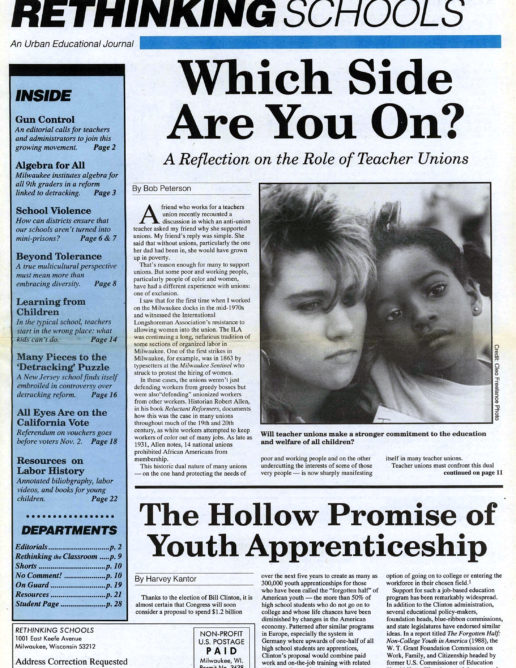All Eyes Are on the California Vote
Voucher Referendum Goes Before Voters Nov. 2
The continuing debate around school vouchers can be summed up in one word this fall: California.
A state-wide referendum Nov. 2 will decide the fate of a constitutional amendment that would give California parents state-funded vouchers to send their children to private schools, including religious schools.
The repercussions of the vote will extend far beyond California’s borders. California is not only the nation’s most populous state, but it has traditionally been viewed as a bellwether in education trends. The voucher referendum is thus being closely watched to determine popular support for what is the most controversial issue in education today.
Referendum supporters admit that they face an uphill battle. Some of the problems are that the referendum includes both non-sectarian and religious schools, has few accountability measures, and would immediately drain needed money from public schools. These have undercut support among people who might, if there were a more carefully constructed referendum, support vouchers.
Under the California proposal, often referred to as Proposition 174, students would be given a voucher worth half of the average spending per public school pupil — or roughly $2,600 per voucher — to attend any private or religious school. Many critics contend the voucher is little more than subsidy to help middle-class parents pay for private schools, since the average tuition for private schools in California is $7,000 a year.
Just about any school that can recruit 25 or more children is eligible to receive vouchers. The private schools would not be required to hire certified teachers, nor would they be required to educate children with special needs. Further, the private schools would be able to discriminate against potential students on the basis of religion, gender, family income, IQ test scores, or physical disabilities. One of the few restrictions is that a school may not discriminate on the basis of race, ethnicity, color or national origin; nor may the schools teach “hatred” of any person based on race, ethnicity, color, national origin, religion, or gender.
The voucher funds would come out of money currently set aside for the funding of public schools. (Under a 1988 measure, California has a “minimum funding guarantee” for public schools.) Thus the referendum has immediate financial repercussions.
There are currently about 550,000 private school students in California. Even if no new children enter private schools, money immediately would be siphoned off from public education to help pay for many of those attending private schools. Voucher opponents estimate that if the referendum
passes, public schools instantly would lose about $2.6 billion, or 10% of their funding. Under the referendum, private school students would not only receive the $2,600 voucher, but an additional $2,600 would be taken from the state’s minimum funding guarantee and put into the state’s general funds.
Funding Cuts
Due to the specific complexities of California’s funding of schools, the potential fiscal nightmare would be even worse when public school students transfer to private schools. If one million students were to leave the public schools, there would be a 20% drop in current public school enrollment. Yet, according to the National Education Association, those public schools would have their funding cut by about 50%.
Critics of the referendum note that such a drop in funding would devastate a public school system already reeling from budget cuts that have led to increased class sizes, shortages of textbooks and supplies, and teacher layoffs and pay cuts in the state. Critics convincingly argue that one of the referendum’s key goals is to legitimize the further defunding of public education.
Referendum supporters themselves have promoted the financial benefits of the initiative. “With 1.8 million new students expected to enter the system over the next eight years, Proposition 174 will be as necessary fiscally as it is educationally,” according to a fact sheet from the pro-voucher group, Yes on 174.
If voters approve the referendum, California would be the first state in the history of this country to institute a state-wide school voucher program. The only existing private school voucher “choice” plan was established in Milwaukee in 1990. Under the proposal, roughly 1,000 low-income students are eligible to receive approximately $2,700 in state funds to attend those private, non-sectarian schools taking part in the program.
The growing fascination with school “choice” proposals naturally follows from the ideology of the Reagan era. Among other characteristics, that era was defined by a flight from public responsibility for social problems, whether poverty, jobs, or homelessness, and a reliance on private enterprise and the marketplace to try to solve such social ills. The push for school vouchers brings this philosophy to the crisis facing public schools.
Unlike health care, housing or jobs, however, public education has historically been viewed in this country as a public responsibility. Equal access to education, while often denied in practice, has traditionally been espoused as an ideal necessary to ensure a well-educated, responsible citizenry.
The concept of publicly funded vouchers for private schools essentially rejects that approach. Education, rather than a public institution accountable to and serving the needs of society at large, becomes the individual concern of individual parents.
Equal access for all is rejected in favor of the best access that money can buy. If some parents have more money than others to buy a better education for their children, then so be it.
The vote in California, therefore, is far more than a state-wide referendum on whether parents want more choices for their children. Fundamentally, it is part of a national battle over the extent to which education will survive as a public institution and responsibility.

